Introduction
This publication discusses Florida residents’ awareness and perceptions of irrigation restrictions to illuminate the processes that support or prevent their compliance with these policies. This information was developed primarily to help water conservation experts, UF/IFAS Extension faculty, environmental management professionals, and water management district personnel understand some of the human dimensions surrounding irrigation restrictions so they can better target the audience they want to educate to improve their compliance. The study’s findings may also be used to inform irrigation water use policies in areas that may experience water scarcity issues in the future.
Irrigation Restrictions in Florida
Rising water demands, particularly in urban areas, present a challenge for stakeholders, researchers, and policymakers as they examine how people use and conserve water in order to improve water management and conservation initiatives (Warner et al., 2020). Urban population growth necessitates an in-depth understanding of the complex dynamics of water consumption to support improved water management and conservation techniques. Irrigation restrictions are frequently used and important tools that can reduce the quantity of water used for residential landscape irrigation (Boyer et al., 2018). As traditional water source scarcity worsens, more locations are using irrigation restrictions to achieve conservation goals (Barnes et al., 2021). Irrigation restrictions can help with outdoor conservation if they are effectively communicated, advertised, and enforced to ensure compliance (Ozan & Alsharif, 2013; Warner et al., 2022). This publication may be used to design outreach, communications, and policies supporting residents’ compliance with irrigation restrictions.
Florida has five water management districts, each in charge of managing water quality and quantity, natural resources, and flood protection. Four (Suwannee River Water Management District, St. Johns River Water Management District, South Florida Water Management District, and Southwest Florida Water Management District) had irrigation restrictions in place when this information was collected. Generally, under these policies, landscape irrigation is only permitted between 1 and 3 days per week, with the exact permitted days determined by street address. Irrigation may also be restricted to certain times of the day. For example, to maximize the effectiveness of the water used, irrigation is restricted during the late morning and early afternoon hours when evaporation rates are highest (Warner et al., 2023). Additionally, irrigation restrictions can differ depending on the water source (e.g., potable versus reclaimed).
Research Approach
An understanding of residents' current irrigation restriction awareness, perceptions, and experiences can be used to target future efforts regarding compliance with landscape irrigation restrictions. The theory of Diffusion of Innovations (Rogers, 2003) served as a framework to assess residents' planned compliance with irrigation restrictions. Diffusion of Innovations explains how innovations could be adopted over time by members of a social system as they gather information and reduce their uncertainty toward or perceived risks of the innovation (e.g., an idea or technology) (Rogers, 2003). The innovation-decision process takes time as people evaluate ideas and decide whether to move forward or not with adopting the innovation (in this case, complying with irrigation restrictions). The five stages of the innovation-decision process are knowledge, persuasion, decision, implementation, and confirmation (Rogers, 2003). For this study, the focus was on the knowledge and persuasion stages, essentially to highlight how outcomes of these stages lead to adoption or rejection decisions.
The innovation-decision process (Figure 1) begins for an individual when they gain knowledge of an innovation's existence and an understanding of the way it functions. At this stage, residents may become aware of existing irrigation restrictions if exposed to different communication channels. The ways in which residents gain awareness may vary: some residents may passively receive messages while others actively seek information. It is common for individuals to expose themselves to ideas and information that align with their interests and needs and are consistent with their attitudes and beliefs (Rogers, 2003). Beliefs and attitudes can be influenced by individuals’ motivation to align with others (Ajzen, 1991). As a result, normative beliefs can affect the ways in which residents gain awareness. Therefore, it is likely that those who are aware of the irrigation restrictions that apply to them have different characteristics from those who are unaware (Warner et al., 2023).
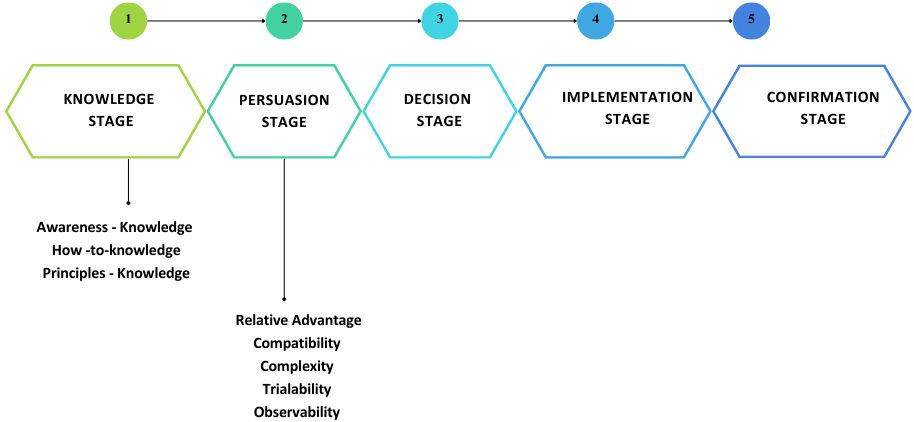
Credit: Sravani Pasula
Residents' intent to comply with irrigation restrictions begins to develop in the persuasion stage of the innovation-decision process. At this stage, individuals who are already aware of the innovation develop positive or negative perceptions towards it, potentially resulting in a behavioral change (Rogers, 2003). Residents will develop perceptions of the innovation by seeking, analyzing, and interpreting the information received and evaluating the social norms in this situation. Therefore, the characteristics of the innovation, such as its relative advantage (the degree to which an innovation is perceived as better than an existing one), compatibility (the degree to which an innovation corresponds with people’s preexisting beliefs, past experiences, and needs), complexity (perceived difficulty in understanding and using the innovation), observability (the degree to which the results of an innovation are visible), and trialability (the degree to which an innovation may be tested on a small scale), can influence the intention to comply with irrigation restrictions.
Methods
The information provided in this publication was gathered through survey research in 2022 from individuals subject to irrigation restrictions (i.e., did not include individuals living in the Northwest Florida Water Management District [NWFWMD], where such restrictions are absent or subject to exemptions for use of alternative water sources, etc.). It provides a comprehensive summary of respondents’ awareness of irrigation restrictions and perceptions of these irrigation restrictions being mandatory or voluntary. The target audience was Floridians at least 18 years of age and to whom irrigation restrictions applied. Altogether, 2,101 Florida residents completed the survey. Screening questions were used to identify the targeted residents and to confirm that participants engaged in decision-making related to their lawn and/or landscape, had automatic (in-ground) sprinklers, used city (municipal) or county water for irrigation, and lived in a water management district that had active irrigation restrictions. After this screening, the sample included 415 Floridians. The respondents were classified as either “aware” or “unaware” based on their responses of “yes” (aware) and “no” or “unsure” (unaware) when asked if their community had irrigation restrictions that applied to them. Descriptive statistics, such as frequencies and percentages, were employed to summarize respondents’ collective awareness, perceptions, and experiences pertaining to irrigation restrictions. Hierarchical linear regression was used to assess the effect of respondents’ perceptions and experiences on participants’ intent to comply with irrigation restrictions.
Awareness of Irrigation Restrictions
Of the 415 residents surveyed, only 52.5% (n = 218) of respondents indicated they were aware of irrigation restriction policies that applied to them, while 41.2% (n = 171) were not aware, and 6.3% (n = 26) were unsure. A 2021 study of Florida residents reported similar awareness levels: 50% (n = 156) reported they were aware of irrigation restrictions imposed in their communities, whereas 39.4% (n = 123) of residents were unaware, and 10.6% (n = 33) were unsure (Warner et al., 2022; Warner et al., 2023).
Voluntary/Mandatory Irrigation Restrictions
Among those respondents who were aware of irrigation restrictions, 61.4% (n = 132) reported they perceived irrigation restrictions as mandatory, 33% (n = 71) reported irrigation restrictions as voluntary, and 5.6% (n =12) were unsure.
Intent to Comply
About 85% of residents who were aware of the irrigation restrictions that applied to them were likely or very likely to follow irrigation restrictions when making decisions about watering their yards (Figure 2).
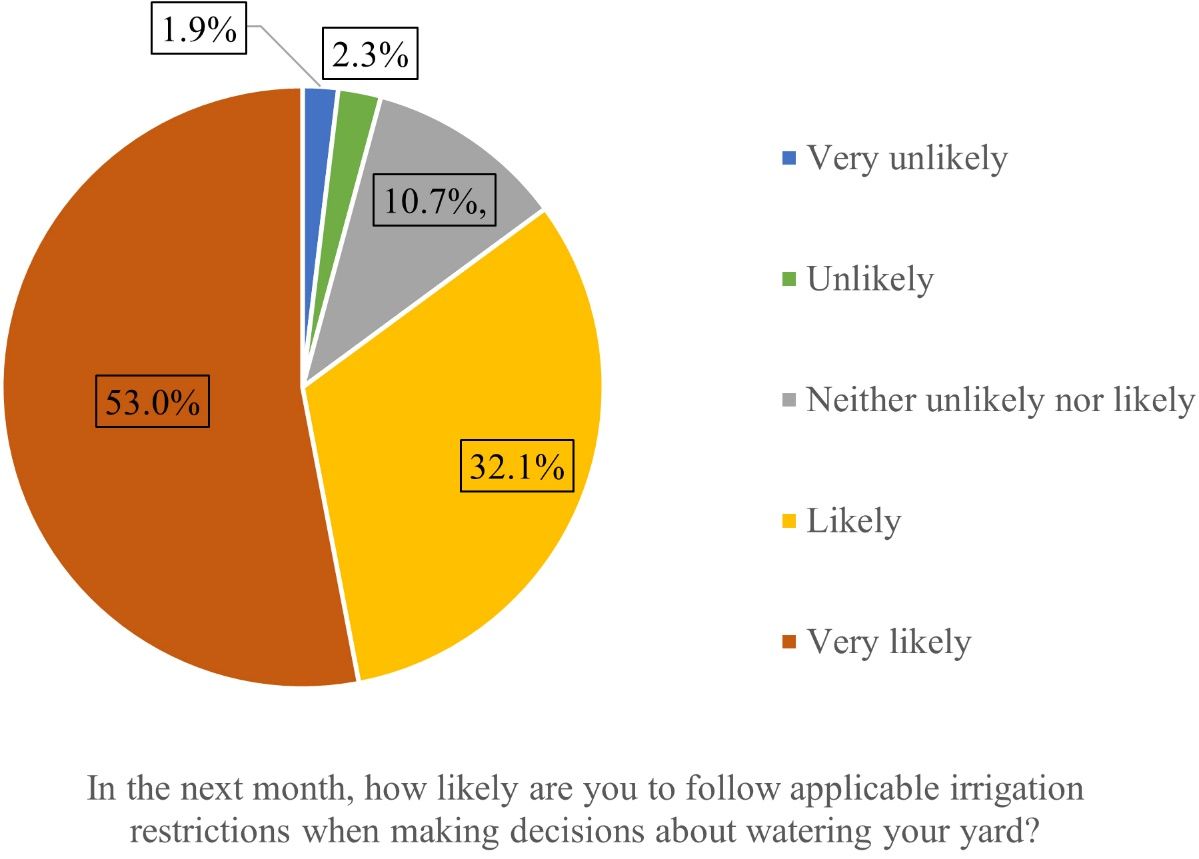
Credit: Sravani Pasula, Dharmendra Kalauni, Laura Warner, John Diaz, Ange Asanzi, James Harmon, Deirdre Irwin, and Robin L. Grantham
Past Compliance
When asked about their past compliance, 93.5% (n = 204) of the aware residents (n = 218) indicated they had previously followed applicable irrigation restrictions when making decisions about watering their yards.
The Relationship between Perceptions and Intent to Comply with Irrigation Restrictions
Overall, residents who were aware of irrigation restrictions had positive perceptions of these policies in terms of relative advantage, compatibility, complexity, trialability, and observability. Intent to comply with irrigation restrictions was significantly determined by the perceived complexity, compatibility, and relative advantage in descending order. For example, if someone’s perception changes so they believe irrigation restrictions are simpler, they would be expected to be more likely to intend to comply with these policies. Moreover, if these restrictions are perceived to fit better or to have greater benefits, the intention to comply would be expected to increase. Perception of water scarcity may also impact the intention to comply with irrigation restrictions. For example, a study conducted in 2022 (Warner et al., 2024) found that residents’ perception of water running out in their lifetime is a significant predictor of their intent to comply with irrigation restrictions.
Adjusting Irrigation Water Use Based on the Cost of Water
Out of the residents who were aware of irrigation restrictions in their communities, 70.6% (n = 154) reported previously adjusting their irrigation water use because of the utility cost for that water. However, 24.3% (n = 53) of the residents had not and 3.7% (n = 8) were unsure.
Normative Beliefs about Irrigation Restrictions
Respondents’ agreement or disagreement regarding beliefs in a given situation revealed what they believe is commonly seen as acceptable (i.e., descriptive norms). Responses showed that 74.8% (n = 163) of respondents agreed or strongly agreed with the notion that similar people will follow irrigation restrictions (Figure 3).
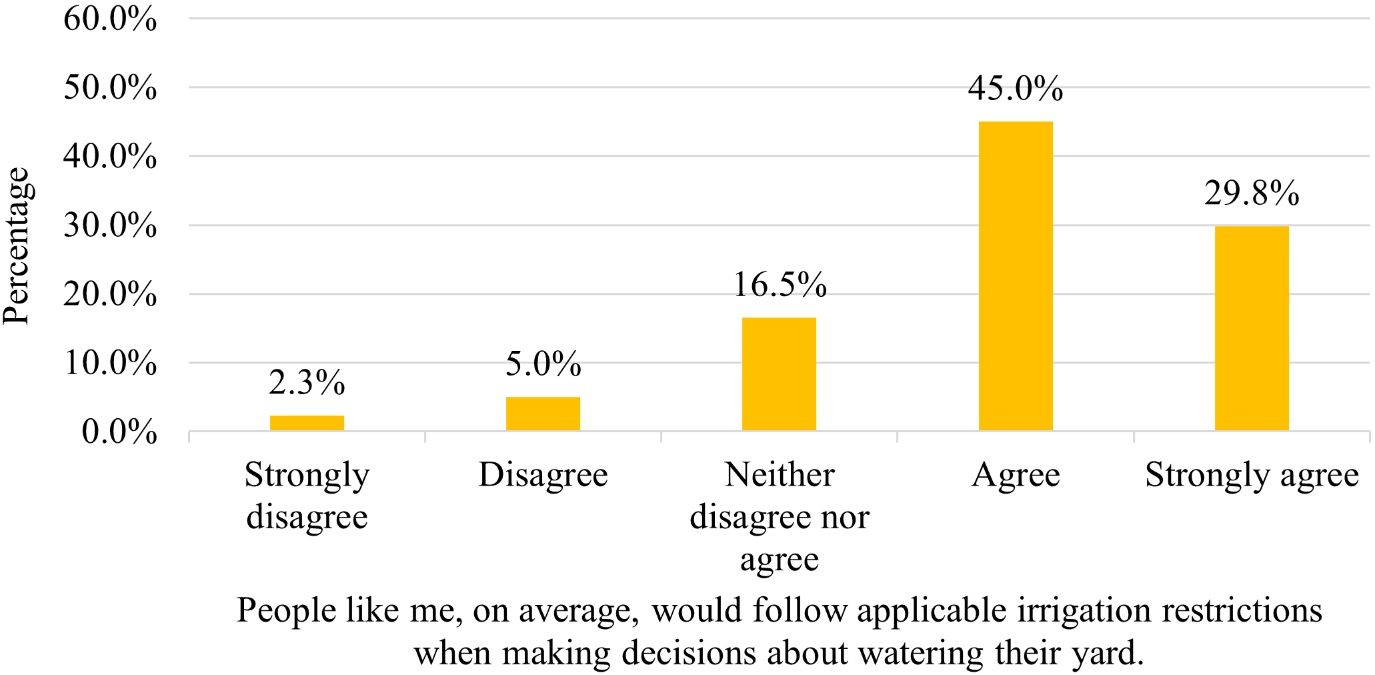
Credit: Sravani Pasula, Dharmendra Kalauni, Laura Warner, John Diaz, Ange Asanzi, James Harmon, Deirdre Irwin, and Robin L. Grantham
Similarly, internalized feelings of obligation (personal norms) to comply with irrigation restrictions were apparent. Nearly 79.8% (n = 174) of the respondents agreed or strongly agreed that they feel obligated to follow applicable irrigation restrictions when making decisions about watering their yards (Figure 4).
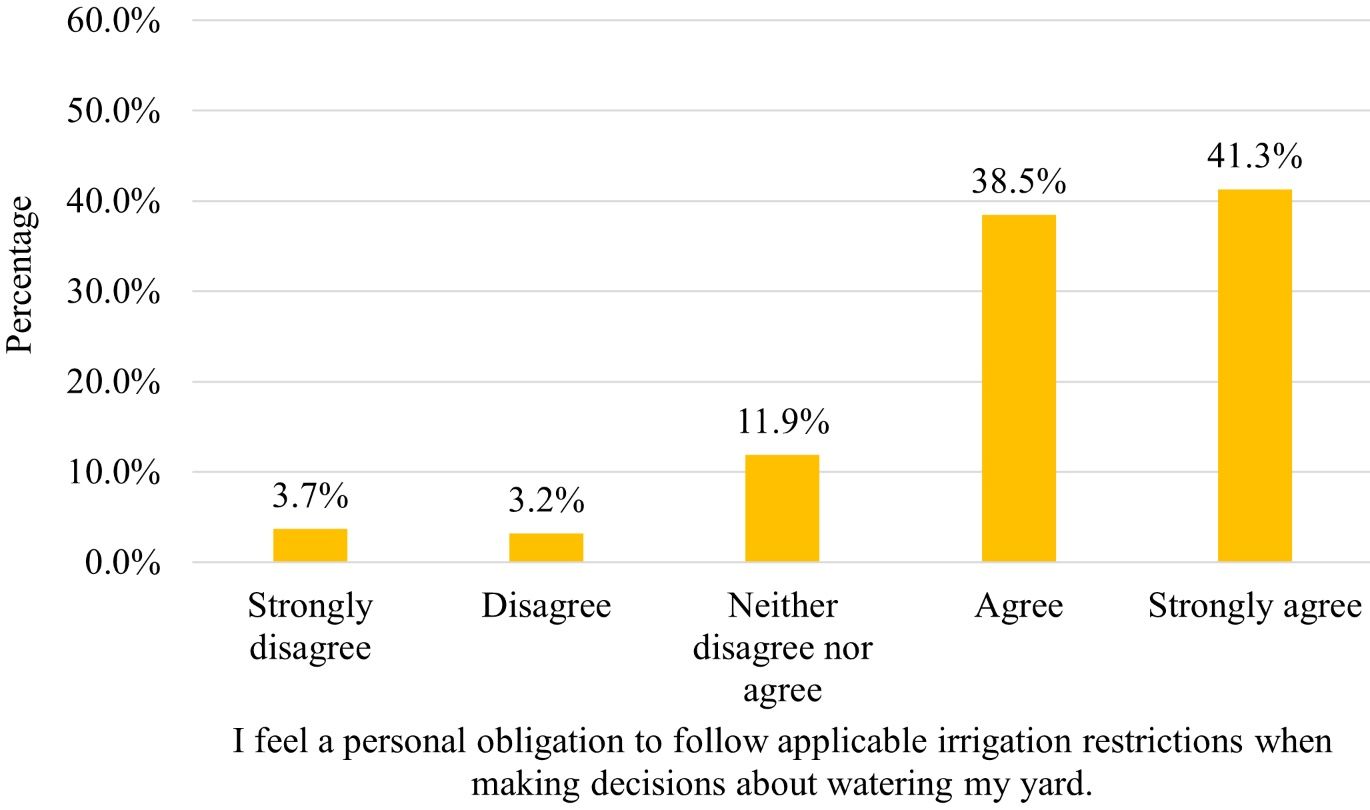
Credit: Sravani Pasula, Dharmendra Kalauni, Laura Warner, John Diaz, Ange Asanzi, James Harmon, Deirdre Irwin, and Robin L. Grantham
Likewise, agreement or disagreement regarding an individual's perception of social pressure or expectations showed 83.1% (n = 181) of residents who were aware of irrigation restrictions agreed or strongly agreed that people like them would approve if they followed applicable irrigation restrictions when making decisions about watering their yards (Figure 5).
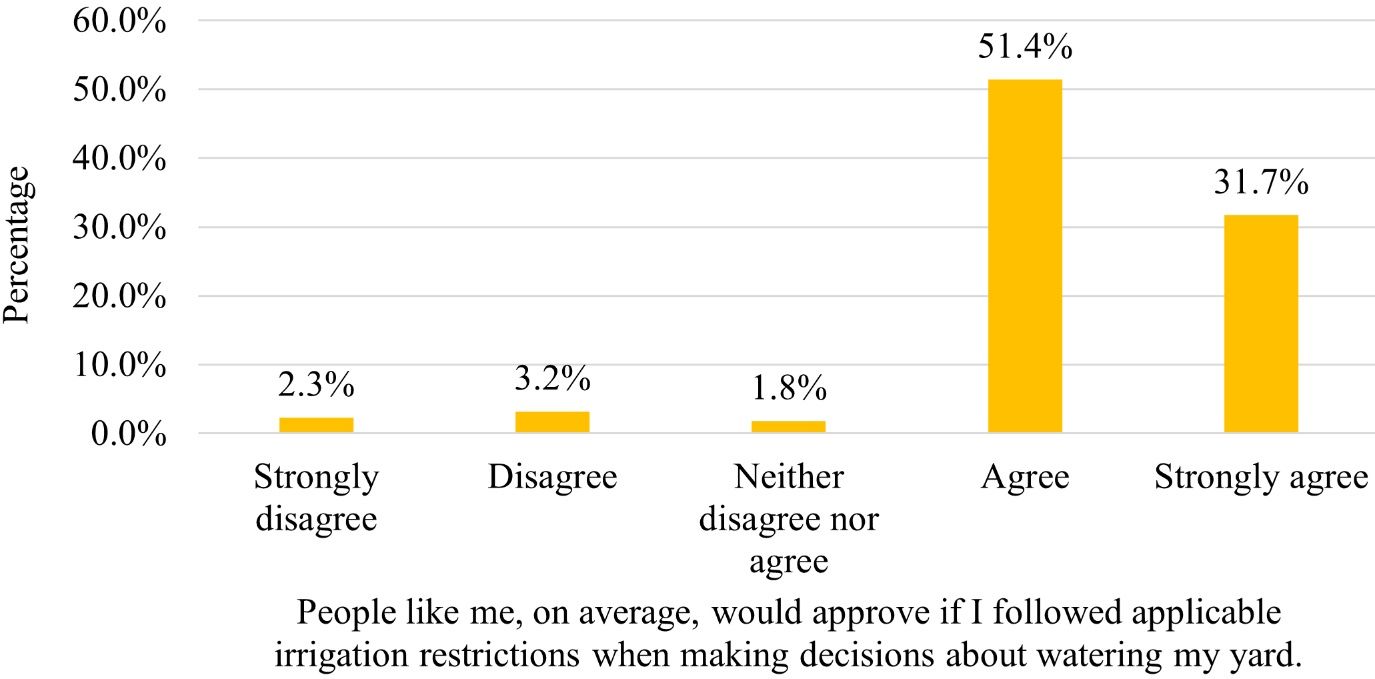
Credit: Sravani Pasula, Dharmendra Kalauni, Laura Warner, John Diaz, Ange Asanzi, James Harmon, Deirdre Irwin, and Robin L. Grantham
Applying This Information
Overall, there seems to be strong internal and external (social) support for complying with irrigation restrictions. However, only about half of the people who are required to follow these policies seem to be aware of them, and only 60% of these aware individuals realize they are mandatory. While this data suggests a grim outlook for overall irrigation restriction compliance, most respondents have followed irrigation restrictions in the past, meaning they likely have the capacity to do so in the future. Water conservation experts, Extension faculty, environmental management professionals, and water management district personnel can use this information to improve compliance and water conservation. Notably, a dual approach should be considered where lack of awareness is addressed among the approximately half of individuals who are unfamiliar with these policies and perceptions are improved among the approximately half of individuals who are aware. Below are a few suggestions for utilizing this information for outreach and educational efforts that improve awareness and compliance.
Utilize the Diffusion of Innovations theory. Use the Diffusion of Innovations theory to structure educational efforts. Consider identifying early adopters who already comply with restrictions. Use their positive experiences and emphasize the relative advantages, compatibility, and trialability of irrigation restrictions to encourage adoption.
Tailor awareness educational campaigns. Only 52.5% of respondents were aware of irrigation restrictions. Educational campaigns can be designed to focus on increasing awareness by disseminating information through various channels such as workshops, community meetings, social media, and local newsletters. Raising awareness among individuals who did not realize there are irrigation restrictions that apply to them can help these residents enter the innovation-decision process. Mass media, as well as information from outside individuals’ social systems, is most important during the knowledge stage (Rogers, 2003), and broad messaging about the existence of irrigation restrictions should be considered to raise awareness.
Address perceived complexity. Compared to other perceptions, perceived complexity relates most strongly to residents' intention to comply with irrigation restrictions. Therefore, information about restrictions should be simplified and clear guidelines provided. This could involve creating easy-to-understand materials, step-by-step instructions, and visuals to make compliance seem less daunting. There is an opportunity to educate policymakers that perceptions of complexity are one of the most likely barriers to compliance so they can simplify irrigation restrictions as appropriate. One specific way to address complexity is to help residents set their controllers correctly and to provide personalized instructions on how to use irrigation technologies properly.
Highlight water scarcity concerns. Given that residents' perception of water scarcity affects their intent to comply with restrictions, the importance of water conservation due to potential water shortages in the future can be emphasized to communicate urgency and responsibility among residents.
Leverage social norms. As normative beliefs play a role in compliance, social norms can be integrated by highlighting that a significant number of residents already follow irrigation restrictions to create a sense of community responsibility and encourage more compliance. When developing perceptions of an innovation, interpersonal channels and information from within an individual’s social system are most important (Rogers, 2003). Neighbors, community members, friends, and family are underused sources of information about this topic (Warner et al., 2022) and should be further engaged.
Provide cost incentives. Because a majority of residents adjusted their irrigation water use based on the cost of water, emphasis might be placed on the cost-saving benefits of adhering to restrictions. This could include information about lower water bills and the environmental and financial benefits of water conservation.
Collaborate with water management districts and other policy-setting entities. There are opportunities to collaborate with water management districts and others responsible for implementing irrigation restrictions. Partners can work together to develop and distribute educational materials, organize workshops, and conduct outreach events to effectively communicate the importance of compliance and the reasons behind the restrictions.
Use real-life examples. Success stories, case studies, personal anecdotes, and testimonials from residents who have benefited from adhering to irrigation restrictions can make information more relatable and persuasive.
Monitor and evaluate. It is important to monitor the effectiveness of educational efforts continuously. Feedback from residents, compliance rates, and changes in awareness and perceptions over time can all be valuable in guiding adjustments to strategies and messaging.
Engage multiple communication channels. To cater to residents' different ways of gaining awareness (e.g., passive vs. active exposure), a mix of communication channels (e.g., in-person events, social media, local news outlets, community forums, and more) should be considered. Some preferred information sources include water management districts and water utilities (Warner et al., 2022).
By applying these strategies and tailoring their approach based on the study's findings, conservation experts such as Extension professionals can effectively promote increased awareness of irrigation restrictions among Florida residents and encourage greater compliance with these regulations.
Conclusion
The information shared in this publication sheds light on the complexities of irrigation restriction compliance by highlighting constraints and opportunities. There is obvious social support for adhering to these regulations, but a considerable barrier exists because only about half of affected individuals are aware of them, and even fewer realize that compliance with these restrictions is mandatory. Understanding the audience is a crucial step that should be undertaken before implementing any communication strategy because different audiences have varying levels of knowledge, interests, attitudes, and behaviors. With an understanding of an audience’s unique needs, a conservation expert, Extension professional, or other practitioner can tailor communication strategies and outreach programs to effectively reach and resonate with each group, which increases the chances of irrigation restrictions being understood, accepted, and acted upon.
Acknowledgments
The UF/IFAS Center for Land Use Efficiency and USDA NIFA Hatch Project 1018367 supported this work.
References
Barnes, M. R., Yue, C., & Watkins, E. (2021). Homeowner perceptions of watering restriction scenarios in the Minneapolis–St. Paul metropolitan area. Crop, Forage & Turfgrass Management, 7(2), e20131. https://doi.org/10.1002/cft2.20131
Boyer, M. J., Dukes, M. D., Duerr, I., & Bliznyuk, N. (2018). Water conservation benefits of long‐term residential irrigation restrictions in southwest Florida. Journal‐American Water Works Association, 110(2), E2–E17. https://doi.org/10.5942/jawwa.2018.110.0019
Ozan, L. A., & Alsharif, K. A. (2013). The effectiveness of water irrigation policies for residential turfgrass. Land Use Policy, 31, 378–384. https://doi.org/10.1016/j.landusepol.2012.08.001
Rogers, E. M. (2003). Diffusion of innovations (3rd ed.). New York: Simon and Schuster.
Warner, L. A., Dukes, M. D., Taylor, N., Irwin, D., & Harmon, J. (2022). A 2021 snapshot of citizens’ awareness and understanding of Florida’s irrigation restrictions: WC418/AEC757, 6/2022. EDIS 2022(3). https://doi.org/10.32473/edis-WC418-2022
Warner, L. A., Cardenas, B., Dukes, M. D., Taylor, N., Irwin, D., Harmon, J., Yazdanpanah, M., & Diaz, J. M. (2023). Insights from residents under year-round irrigation restrictions to improve water conservation impacts. AWWA Water Science, 5(4), e1348. https://doi.org/10.1002/aws2.1348
Warner, L. A., Lamm, A. J., & Silvert, C. (2020). Diffusion of water-saving irrigation innovations in Florida’s urban residential landscapes. Urban Forestry & Urban Greening, 47, 126540. https://doi.org/10.1016/j.ufug.2019.126540
Warner, L. A., Kalauni, D., Diaz, J. M., Yazdanpanah, M., & Pasula, S. (2024). Beyond awareness: the persuasion stage of decision-making explains urban residents’ compliance with landscape irrigation restrictions. Urban Water Journal, 1–12. https://doi.org/10.1080/1573062X.2024.2312498